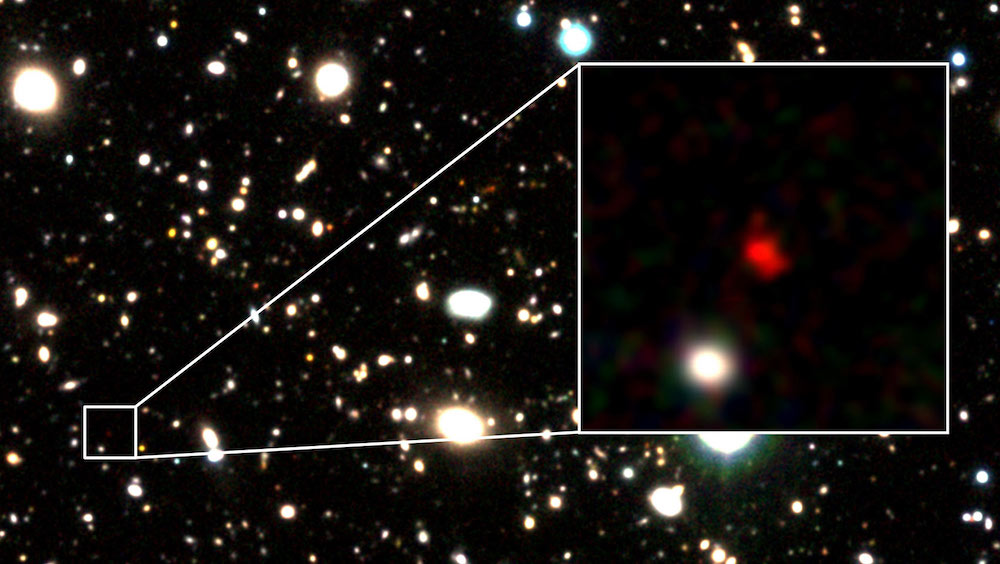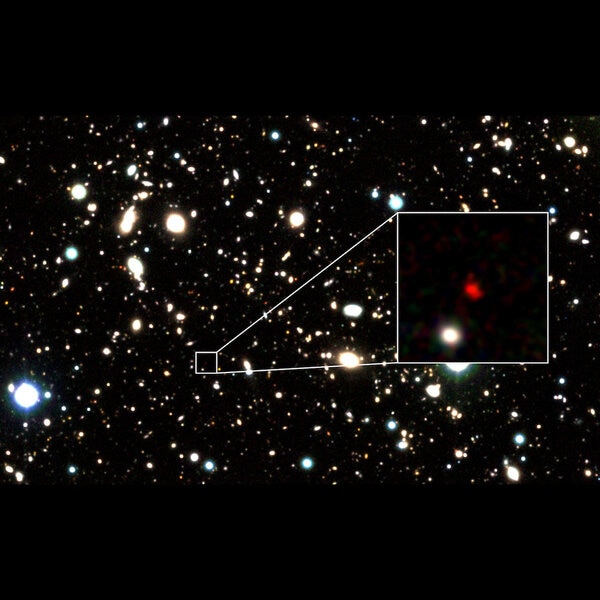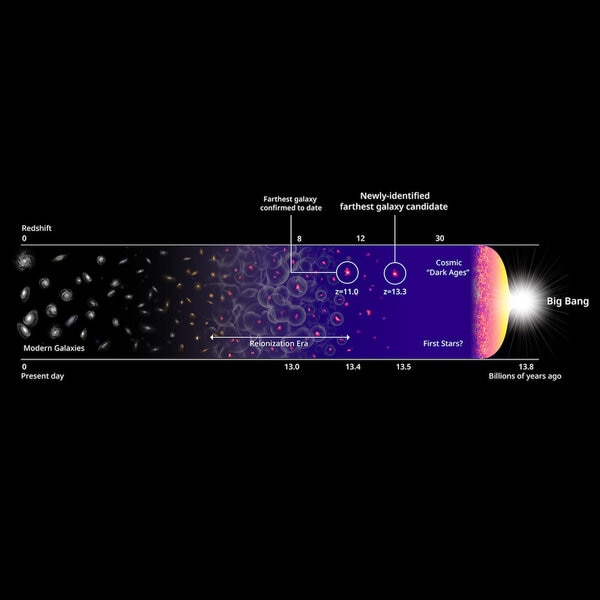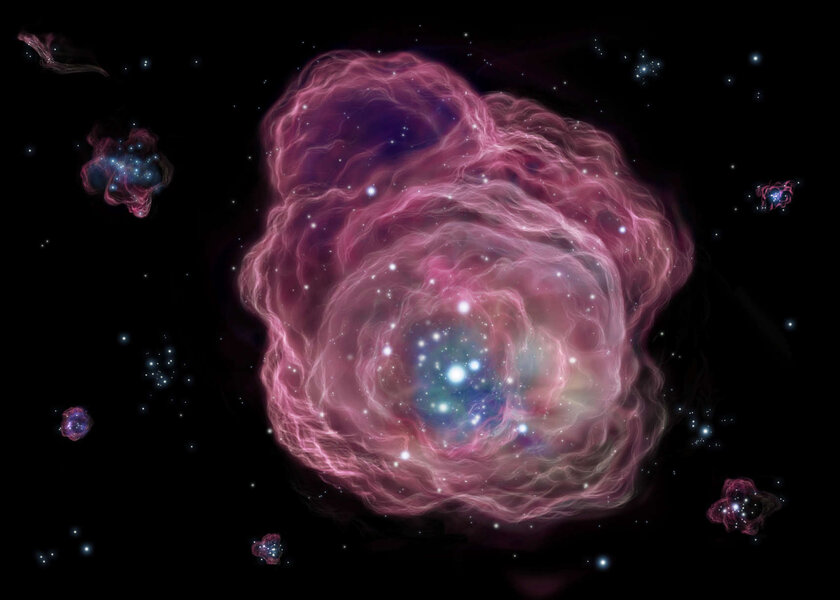Create a free profile to get unlimited access to exclusive videos, sweepstakes, and more!
The (maybe) most distant galaxy ever seen smashes the old record... by a lot
If confirmed, HD1 is the most distant galaxy seen, 13.5 billion light-years away!

Astronomers may have found two galaxies that not only break the record for most distant ever seen, they’ve crushed it. These galaxies are so far away their light has taken well over 13 billion years to reach us, and we see them as they were just a little over 300 million years after the Big Bang itself!
The galaxies were found in extremely deep — meaning they see very faint objects — surveys using Subaru, UKIRT, VISTA, and Spitzer Space Telescope. These all detect infrared light, which is the key here because of two things. First, very distant galaxies should be forming stars at a furious rate as well as blasting out energy as their central supermassive black holes feed on material falling into them. Both of these processes emit a lot of ultraviolet light.
Second, the Universe is expanding. As it does so, distant objects are swept away from us as space grows. This stretches out the wavelength of the light they emit similar to the more familiar Doppler shift of sound. We call this redshifting, and the more distant the object the more its light is redshifted.
Very distant galaxies should have their wavelength stretched by a huge amount, by more then ten times. Ultraviolet light emitted by an extremely distant galaxy will have its light redshifted to the infrared, so we use IR telescopes to look for it.
This gets fun, so bear with me: Almost all the gas in the early Universe was hydrogen. Hydrogen atoms really love to absorb ultraviolet light, and if the atom absorbs a UV photon at a critical wavelength — 0.1216 microns, also called Lyman alpha for historical reasons — the electron in a hydrogen atom gets blown off like shrapnel. Any shorter wavelength light will get absorbed, but photons with wavelengths longer than that can get past. When we look at nearby galaxies that emit a lot of UV light, they don’t emit light with wavelengths shorter than Lyman alpha. It cuts off there.
That gives astronomers a way to get the redshift of a distant galaxy: By looking at it using a bunch of different filters that select for specific wavelengths and arranging them from blue to red, they can look for where they suddenly start seeing light from the galaxy. At a certain redshift, the bluest filters see no light, but then suddenly the galaxy appears in a redder filter. We know the wavelength of that filter, so that tells us how much the Lyman cutoff got redshifted. That gives the distance to the galaxy.
So astronomers used those IR telescopes to measure the colors of thousands of galaxies in the surveys, looking for the Lyman cutoff. For two galaxies they found it had been hugely redshifted into the infrared, indicating immense distance.
They call these galaxies HD1 and HD2. The first has a redshift factor of 13.3, the second 12.3. That means we see these galaxies as they were 310 and 340 million years after the Big Bang, or, if you prefer, it took their light about 13.5 and 13.45 billion years to reach us*.
Whoa.
GN-z11, the farthest galaxy ever seen before this, has a redshift of about 11, so we see it as it was roughly 400 million years after the Universe formed. HD1 and HD2 galaxies are farther away.
What’s interesting about these two galaxies besides their distance is how bright they are; they’re emitting a lot more ultraviolet light than expected. There could be two reasons for this. One is that they’re forming stars much faster than expected, between 5 – 24 times as much as what models indicated. What caught my attention is that if this is true they’re making a lot more massive stars than expected, too. It’s thought that early on in the Universe, when there was only hydrogen and helium around to make stars, they could grow to enormous size, far larger than stars we see today. We still haven’t seen these first generation stars yet — though we have candidates — but all the extra UV light pouring out of these galaxies means it could be coming from them.
The second reason is that these galaxies could be quasars, where their central supermassive black holes are actively feeding on material and blasting out high-energy radiation. If so, the black holes would have to be one or two hundred million times the mass of the Sun. We see bigger ones than that, but remember we’re seeing these galaxies as they were when they were young. It takes time to build up a huge black hole, and 310 million years is not a long time. Models indicate it’s just possible to get them that big by that time, if they were born somewhat massive to start with and feed very rapidly.
While the evidence for these two galaxies being record breakers is pretty compelling, it’s not proof. That may have to wait for telescopes like the James Webb Space Telescope to confirm, since it too sees in the infrared and has a big enough mirror to see such faint galaxies. It can take spectra that could prove or refute the huge redshift.
That may take a year or two to determine. JWST may find more such galaxies, as could the Nancy Roman Space Telescope, planned for launch in a few years as well.
These galaxies may indeed be the farthest ever seen, but the really interesting bit is that they may not hold that record for long.
* These numbers of time and distance depend on the shape and structure of the Universe, which is usually not a problem, but we’re talking about objects so close to the observable edge of the Universe that they become important. A slight change in, say, the density of matter you assume translates into a big change in distance. For this article I’m using the same numbers as the published papers to get the distances, but you might see slightly different numbers in other articles. Don’t worry about the exact numbers, but instead look at the bigger picture that we’re seeing farther back in the Universe than ever before.





























